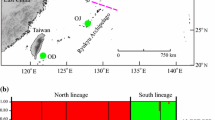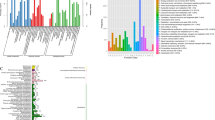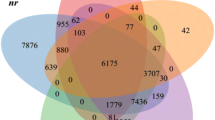Abstract
Dysosma (Berberidaceae), which comprises seven herbaceous perennial species, has long been used as main sources of a traditional Chinese medicine, “Guijiu.” Despite its ecological and economic importance, molecular research of Dysosma has lagged behind because of the shortcoming of molecular markers. In this study, a cDNA library of D. versipellis leaves was sequenced using the Illumina HiSeq™ 2000 sequencing system. A total of 44,855 nonredundant unigenes were assembled from 57.6 million reads, and 5,167 expressed sequence tag–simple sequence repeats (EST–SSRs) were identified in 4,536 unigenes. Trinucleotide motifs were the most common type, with a frequency of 43.7 % (2,260). Among the 5,167 EST–SSRs, 1,050 primer pairs were successfully designed. After selecting 80 of these pairs at random for further validation, 19 pairs were identified as true-to-type SSR loci, and 14 of those could reliably amplify polymorphic bands from 12 individuals of D. versipellis. These 14 EST–SSR markers showed high average genetic diversity (e.g., N A = 6.29; H E = 0.528), when surveyed across four D. versipellis populations, and were also transferable to almost all other Dysosma species, excepting one marker (four instead of six species). Finally, 11 polymorphic markers were chosen to provide insights into the population structure of D. versipellis and its presumed sister species, D. pleiantha. Both genetic distance and structure analyses identified two genetic clusters largely congruent with the current species classification. These findings indicate that the EST–SSRs examined can be used with confidence in future population genetic studies of both D. versipellis and D. pleiantha.


Similar content being viewed by others
References
Antao T, Lopes A, Lopes RJ, Beja-Pereira A, Luikart G (2008) LOSITAN: a workbench to detect molecular adaptation based on a Fst-outlier method. BMC Bioinform 9:323
Beaumont MA, Nichols RA (1996) Evaluating loci for use in the genetic analysis of population structure. Proc R Soc Lond B Biol Sci 263:1619–1626
Bouck A, Vision T (2007) The molecular ecologist’s guide to expressed sequence tags. Mol Ecol 16:907–924
Cardle L, Ramsay L, Milbourne D, Macaulay M, Marshall D, Waugh R (2000) Computational and experimental characterization of physically clustered simple sequence repeats in plants. Genetics 156:847–854
Carlsson J (2008) Effects of microsatellite null alleles on assignment testing. J Hered 99:616–623
Chapuis MP, Estoup A (2007) Microsatellite null alleles and estimation of population differentiation. Mol Biol Evol 24:621–631
Clark AG, Glanowski S, Nielsen R, Thomas PD, Kejariwal A, Todd MA, Tanenbaum DM, Civello D, Lu F, Murphy B, Ferriera S, Wang G, Zheng X, White TJ, Sninsky JJ, Adams MD, Cargill M (2003) Inferring non-neutral evolution from human-chimp-mouse orthologous gene trios. Science 302:1960–1963
Dempster AP, Laird NM, Rubin DB (1977) Maximum likelihood from incomplete data via the EM algorithm. J R Stat Soc B 39:1–38
Du FK, Xu F, Qu H, Feng SS, Tang JJ, Wu RL (2013) Exploiting the transcriptome of Euphrates Poplar, Populus euphratica (Salicaceae) to develop and characterize new EST–SSR markers and construct an EST–SSR database. PLoS ONE 8:61337
Ellis JR, Burke JM (2007) EST–SSRs as a resource for population genetic analyses. Heredity 99:125–132
Eujayl I, Sledge MK, Wang L, May GD, Chekhovskiy K, Zwonitzer JC, Mian MAR (2003) Medicago trunculata EST–SSRs reveal cross-species genetic markers for Medicago spp. Theor Appl Genet 108:414–422
Evanno G, Regnaut S, Goudet J (2005) Detecting the number of clusters of individuals using the software STRUCTURE: a simulation study. Mol Ecol 14:2611–2620
Giri A, Narasu ML (2000) Production of podophyllotoxin from Podophyllum hexandrum: a potential natural product for clinically useful anticancer drugs. Cytotechnology 34:17–26
Goudet J (2001) Fstat, a program to estimate and test gene diversities and fixation indices. Version 2.9.3. http://www2.unil.ch/popgen/softwares/fstat.htm
Grabherr MG, Haas BJ, Yassour M, Levin JZ, Thompson DA, Amit I, Adiconis X, Fan L, Raychowdhury R, Zeng QD, Chen ZH, Mauceli E, Hacohen N, Gnirke A, Rhind N, Palma FD, Birren BW, Nusbaum C, Lindblad-Toh K, Friedman N, Regev A (2011) Full-length transcriptome assembly from RNA-Seq data without reference genome. Nat Biotechnol 29:644–652
Guan BC, Qiu YX, Fu CX (2008) Isolation and characterization of microsatellite markers in Dysosma versipellis (Berberidaceae), a rare endemic from China. Conserv Genet 9:783–785
Guan BC, Fu CX, Qiu YX, Zhou SL, Comes HP (2010) Genetic structure and breeding system of a rare understory herb, Dysosma versipellis (Berberidaceae), from temperate deciduous forests in China. Am J Bot 97:111–122
Guan BC, Gong X, Zhou SL (2011) Development and characterization of polymorphic microsatellite markers in Dysosma pleiantha (Berberidaceae). Am J Bot 9:210–212
Guichoux E, Lagache L, Wagner S, Chaumel P, Ger PLE, Lepais O, Lepoittrvin C, Malausa T, Revardel E, Salin F, Petit RJ (2011) Current trends in microsatellite genotyping. Mol Ecol Res 11:591–611
Gupta PK, Rustgi S, Sharma S, Singh R, Kumar N, Balyan HS (2003) Transferable EST–SSR markers for the study of polymorphism and genetic diversity in bread wheat. Mol Genet Genomics 270:315–323
Hodgetts RB, Aleksiuk MA, Brown A, Clarke C, Macdonald E, Nadeem S, Khasa D, Macdonald E (2001) Development of microsatellite markers for white spruce (Picea glauca) and related species. Theor Appl Genet 102:1252–1258
IUCN (2013) IUCN red list of threatened species. Version 2013.2. www.iucnredlist.org
Jurka J, Pethiyagoda C (1995) Simple repetitive DNA sequences from primates: compilation and analysis. J Mol Evol 40:120–126
Kalinowski ST, Taper ML, Marshall TC (2007) Revising how the computer program CERVUS accommodates genotyping error increases success in paternity assignment. Mol Ecol 16:1099–1106
Kantety RV, Rota ML, Matthews DE, Sorrells ME (2002) Data mining for simple sequence repeats in expressed sequence tags from barley, maize, rice, sorghum and wheat. Plant Mol Biol 48:501–510
Kim KS, Ratcliffe ST, French BW, Liu L, Sappington TW (2008) Utility of EST-derived SSRs as population genetics markers in a beetle. J Hered 99:112–124
Koilkonda P, Sato S, Tabata S, Shirasawa K, Hirakawa H, Sakai H, Sasamoto S, Watanabe A, Wada T, Kishida Y, Tsuruoka H, Fujishiro T, Yamada M, Kohara M, Suzuki S, Hasegawa M, Kiyoshima H, Isobe S (2012) Large-scale development of expressed sequence tag-derived simple sequence repeat markers and diversity analysis in Arachis spp. Mol Breed 30:125–138
Kumari K, Muthamilarasan M, Misra G, Gupta S, Subramanian A, Parida SK, Chattopadhyay D, Prasad M (2013) Development of eSSR-markers in Setaria italica and their applicability in studying genetic diversity, cross-transferability and comparative mapping in millet and non-millet species. PLoS ONE 8:67742
Kumpatla SP, Mukhopadhyay S (2005) Mining and survey of simple sequence repeats in expressed sequence tags of dicotyledonous species. Genome 48:985–998
Lee C (2012) Monolignol and lignan biosynthetic studies: from reaction mechanisms to next generation sequencing. PhD thesis, Washington State University
Li YC, Korol AB, Fahima T, Nevo E (2004) Microsatellites within genes: structure, function, and evolution. Mol Biol Evol 21:991–1007
Li DJ, Deng Z, Qin B, Liu XH, Men ZH (2012) De novo assembly and characterization of bark transcriptome using Illumina sequencing and development of EST–SSR markers in rubber tree (Hevea brasiliensis Muell. Arg.). BMC Genom 13:192
Liu TM, Zhu SY, Tang QM, Chen P, Yu YT, Tang SW (2013a) De novo assembly and characterization of transcriptome using Illumina paired-end sequencing and identification of CesA gene in ramie (Boehmeria nivea L. Gaud). BMC Genom 14:125
Liu ZP, Chen TL, Ma LC, Zhao ZG, Zhao PX, Nan ZB, Wang YR (2013b) Global transcriptome sequencing using the Illumina platform and the development of EST–SSR markers in autotetraploid alfalfa. PLoS ONE 8:e83549
Luro FL, Costantino G, Terol J, Argout X, Allario T, Wincker P, Talon M, Ollitrault P, Morillon R (2008) Transferability of the EST–SSRs developed on Nules clementine (Citrus clementina Hort ex Tan) to other Citrus species and their effectiveness for genetic mapping. BMC Genom 9:287
Mao YR, Zhang YH, Nakamura K, Guan BC, Qiu YX (2014) Developing DNA barcodes for species identification in Podophylloideae (Berberidaceae). J Syst Evol. doi:10.1111/jse.12076
Metzgar D, Bytof J, Wills C (2000) Selection against frameshift mutations limits microsatellite expansion in coding DNA. Genome Res 10:72–80
Morgante M, Hanafey M, Powell W (2002) Microsatellites are preferentially associate with nonrepetitive DNA in plant genomes. Nat Genet 30:194–200
Nei M, Tajima F, Tateno Y (1983) Accuracy of estimated phylogenetic trees from molecular data II. Gene frequency data. J Mol Evol 19:153–170
Parchman T, Geist K, Grahnen J, Benkman C, Buerkle CA (2010) Transcriptome sequencing in an ecologically important tree species: assembly, annotation, and marker discovery. BMC Genom 11:180
Pashley CH, Ellis JR, McCauley DE, Burke JM (2006) EST databases as a source for molecular markers: lessons from Helianthus. J Hered 97:381–388
Peng JH, Nora L, Lapitan V (2005) Characterization of EST-derived microsatellites in the wheat genome and development of eSSR markers. Funct Integ Genomics 5:80–96
Pertea G, Huang X, Liang F, Antonescu V, Sultana R et al (2003) TIGR Gene Indices clustering tools (TGICL): a software system for fast clustering of large EST datasets. Bioinformatics 19:651–652
Pritchard JK, Stephens M, Donnelly P (2000) Inference of population structure using multilocus genotype data. Genetics 155:945–959
Qiu YX, Zhou XW, Fu CX, Gilbert CYS (2005) A preliminary study of genetic variation in the endangered, Chinese endemic species Dysosma versipellis (Berberidaceae). Bot Bull Acad Sin 46:61–69
Qiu YX, Li JH, Liu HL, Chen YY, Fu CX (2006) Population structure and genetic diversity of Dysosma versipellis (Berberidaceae), a rare endemic from China. Biochem Syst Ecol 34:745–752
Qiu YX, Guan BC, Fu CX, Comes HP (2009) Did glacials and/or interglacials promote allopatric incipient speciation in East Asian temperate plants? Phylogeographic and coalescent analyses on refugial isolation and divergence in Dysosma versipellis. Mol Phylogenet Evol 51:281–293
Rajora OP, Mosseler A, Major JE (2000) Indicators of population viability in red spruce, Picea rubens. II. Genetic diversity, population structure, and mating behaviour. Can J Bot 78:941–956
Rousset F (2008) Genepop’007: a complete re-implementation of the genepop software for Windows and Linux. Mol Ecol Resour 8:103–106
Roy C, Brown D, Little JE, Valentine BK, Walker PR, Sikorska M, Leblanc J, Caly N (1992) The topoisomerase II inhibits teniposide (VM-26) induced apoptosis in unstimulated mature murine lymphocytes. Exp Cell Res 200:416
Rozen S, Skaletsky H (1999) Primer3 on the WWW for general users and for biologist programmers. Methods Mol Biol 132:365–386
Scotti I, Paglia GP, Magni F, Morgante M (2002) Efficient development of dinucleotide microsatellite markers in Norway spruce (Picea abies Karst.) through dot-blot selection. Theor Appl Genet 104:1035–1041
Shang MY, Xu GJ, Xu LS, Li P (1994) Herbalogical study of Chinese drug guijiu and xiaoyelian. J Tradit Chin Med 19:451–453 (in Chinese with an English abstract)
Takezaki N, Nei M, Tamura K (2009) Poptree2: software for constructing population trees from allele frequency data and computing other population statistics with Windows-interface. http://www.med.kagawa-u.ac.jp/~genomelb/takezaki/poptree2/index.html
Tatusov RL, Fedorova ND, Jackson JD, Jacobs AR, Kiryutin B, Koonin EV, Krylov DM, Mazumder R, Mekhedov SL, Nikolskaya AN et al (2003) The COG database: an updated version includes eukaryotes. BMC Bioinform 4:41
Thiel T, Michalek W, Varshney RK, Graner A (2003) Exploiting EST databases for the development of cDNA derived microsatellite markers in barley (Hordeum vulgare L.). Theor Appl Genet 106:411–422
Tiffin P, Hahn MW (2002) Coding sequence divergence between two closely related plant species: Arabidopsis thaliana and Brassica rapa ssp. pekinensis. J Mol Evol 54:746–753
Toth G, Gaspari Z, Jurka J (2000) Microsatellites in different eukaryotic genomes: survey and analysis. Genome Res 10:967–981
Varshney RK, Sigmunda R, Börnera A, Korzunb V, Steina N, Sorrellsc ME, Langridged P, Graner A (2005a) Interspecific transferability and comparative mapping of barley EST–SSR markers in wheat, rye and rice. Plant Sci 168:195–202
Varshney RK, Graner A, Sorrells ME (2005b) Genic microsatellite markers in plants: features and applications. Trends Biotechnol 23:48–55
Wang S, Xie Y (2004) China species red list (vol 1 Red List). Higher Education Press, Beijing
Wang ZY, Fang BP, Chen JY, Zhang XJ, Luo ZX, Huang LF, Chen XL, Li YJ (2010) De novo assembly and characterization of root transcriptome using Illumina paired-end sequencing and development of cSSR markers in sweetpotato (Ipomoea batatas). BMC Genom 11:726
Wang ZY, Li J, Luo ZX, Huang LF, Chen XL, Fang BP, Li YJ, Chen JY, Zhang XJ (2011) Characterization and development of EST-derived SSR markers in cultivated sweetpotato (Ipomoea batatas). BMC Plant Biol 11:139
Wang HB, Jiang JF, Chen SM, Qi XY, Peng H, Li PR, Song AP, Guan ZY, Fang WM, Liao Y, Chen FD, Chen FD (2013) Next-generation sequencing of the Chrysanthemum nankingense (Asteraceae) transcriptome permits large-scale unigene assembly and SSR marker discovery. PLoS ONE 8:e62293
Ying TS, Zhang YL, Boufford DE (1993) The endemic genera of seed plants of China. Science Press, Beijing
Zane L, Bargelloni L, Patarnello T (2002) Strategies for microsatellite isolation: a review. Mol Ecol 11:1–16
Zeng SH, Xiao G, Guo J, Fei ZJ, Xu YQ, Roe BA, Wang Y (2010) Development of a EST dataset and characterization of EST–SSRs in a traditional Chinese medicinal plant, Epimedium sagittatum (Sieb. et Zucc.) Maxim. BMC Genom 11:94
Zheng XF, Pan C, Diao Y, You YN, Yang CZ, Hu ZL (2013) Development of microsatellite markers by transcriptome sequencing in two species of Amorphophallus (Araceae). BMC Genom 14:490
Zong M, Liu HL, Qiu YX, Yang SZ, Zhao MS, Fu CX (2008) Genetic diversity and geographic differentiation in the threatened species Dysosma pleiantha in China as revealed by ISSR analysis. Biochem Genet 46:180–196
Acknowledgments
This research was supported by the National Science Foundation of China (Nos. 31170200, 30900082), the Zhejiang Provincial Funds for Distinguished Young Scientists (No. LR02001), the Fundamental Research Funds for the Central Universities (No. 2011QNA6013), the Qianjiang talent project from Bureau of Science and technology of Zhejiang Province, China (No. 2010R10090). We are grateful to Hans-Peter Comes (University of Salzburg) and three anonymous reviewers for their insightful comments and suggestions to improve the manuscript.
Author information
Authors and Affiliations
Corresponding author
Additional information
Rui Guo and Yun-Rui Mao have contributed equally to this work.
Electronic supplementary material
Below is the link to the electronic supplementary material.
Rights and permissions
About this article
Cite this article
Guo, R., Mao, YR., Cai, JR. et al. Characterization and cross-species transferability of EST–SSR markers developed from the transcriptome of Dysosma versipellis (Berberidaceae) and their application to population genetic studies. Mol Breeding 34, 1733–1746 (2014). https://doi.org/10.1007/s11032-014-0134-z
Received:
Accepted:
Published:
Issue Date:
DOI: https://doi.org/10.1007/s11032-014-0134-z




